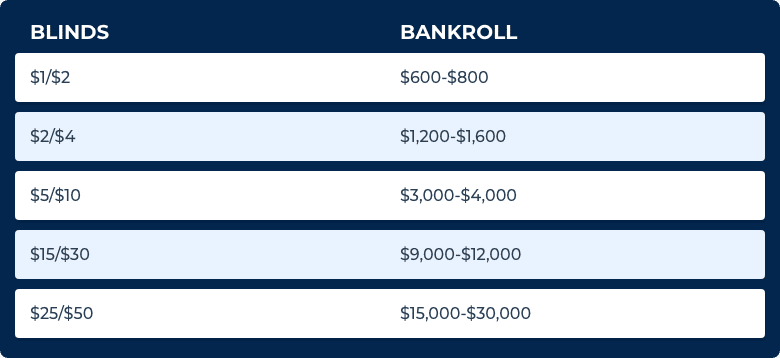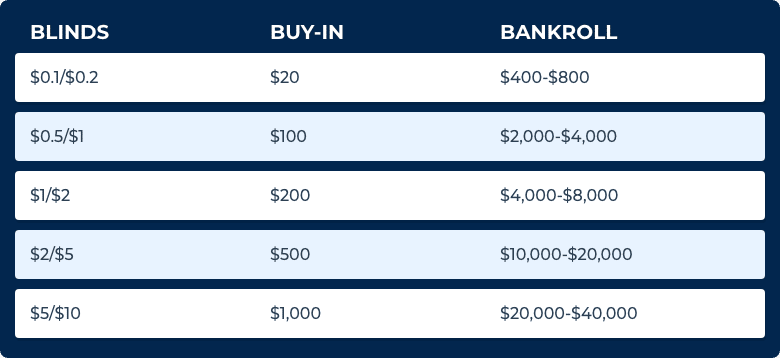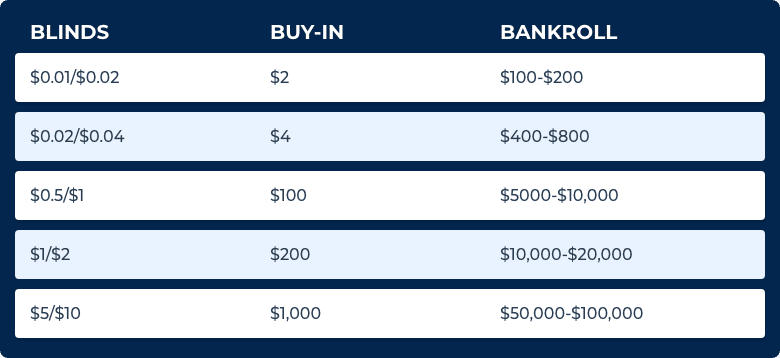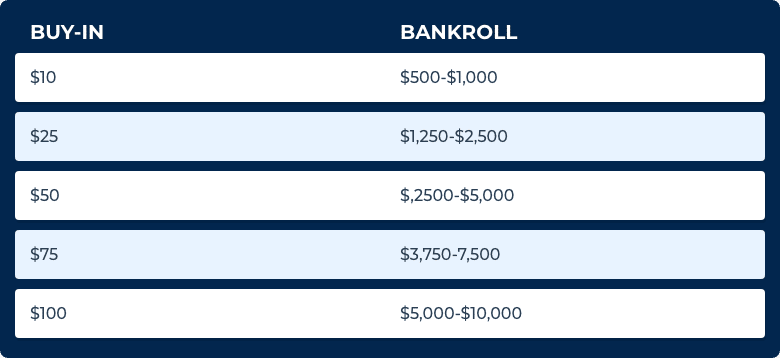Poker Bankroll Management: How To Manage Your Funds for Playing Poker
Poker can be an exciting game you enjoy for fun or a serious profession on which you base your livelihood. Either way, you’ll need to secure enough funds if you want to play it on a regular basis.
One of the most important aspects of the game, which is often overlooked, is your poker bankroll management. If you ask the pros, it will be near the top of their list of skills to have if you want to be a successful poker player.
This article will cover all the basics of bankroll management and show you how to apply it to get the best out of your game.
Building a Poker Bankroll
If you’re wondering how to build a poker bankroll, you need to start by asking yourself what poker formats you will be playing most of the time.
Live tournament games are going to be played at a more predictable tempo than an online poker tournament, so you can make do with a smaller bankroll.
With cash games, it will be easy to track your progress and know when to raise the stakes and when to change tables. All these games require different strategies if you plan on doing well.
Micro stakes poker will not interfere with your overall budget, so it may seem you don’t have to plan a bankroll for these tables. But it is good to approach those games seriously if you want to learn discipline in governing your assets for the time when you start playing with higher stakes.
Generally, when building a poker bankroll, it is a good idea to have funds for gambling set aside and know how much you are prepared to lose on a given day. Make sure you know the dynamics of each poker format you plan on playing.
It takes a lot of experience to recognize your strengths and weaknesses in different types of poker games that exist these days. We’ve prepared a list of the most popular poker formats and the bankroll you should have to play the game.
It should provide you with a solid starting point, and with time, you will have your own poker bankroll management chart and know where you stand on any given day. Keep in mind that different rules apply when talking about professional players. They will have to count on at least double the bankroll that an amateur would need.
You have to keep enough assets secure in case of a losing streak because you don’t need more money for new games to reclaim those losses; you’ll also have to consider the funds you require for living expenses.
Planning Your Bankroll for the Different Games
With your funds for poker set aside, you need to look out for the tempo of the games you may be joining. Bankroll management for online poker will differ compared to managing your funds if you’re playing live cash games only. You should treat each format separately and prepare accordingly.
Playing Cash Games in Poker
When you’re playing cash games, you only need to keep track of your bb/100 rates. If your winning rate is around five big blinds taken for every 100 hands played, you can be sure that the odds are in your favor at the moment, and you can afford to push the stakes up.
Your cash games poker bankroll for limit games should always be around 300 – 400 big blinds.
If you’re playing micro stakes poker, you should stick to the same principles if you want to build the habit of gambling responsibly in the future.
When you’re playing No Limit cash games you should count on a bankroll in the amount of 20 to 40 times what the buy-in is for the game that you intend to play.
Playing Sit-and-Go
Playing sit-and-go tournaments can requires different strategies depending on the type of the game you find yourself in. The variance in these games is usually on the higher end of the spectrum, and the ROI is not that big to start with.
Therefore, you should look for an online poker bankroll management strategy to protect you from losing more than you can afford. As with all online games, you need to be careful and be sure you can handle the rate at which the blinds are going.
You should have from 50 to 100 worth of buy-ins in backup to level out any eventual losing streaks and bring more consistency to your game.
Playing Live Tournaments
Poker bankroll management for tournaments is not difficult to master, as the tempo of the game is predictable whether you play in a live casino or a brick-and-mortar one.
Playing Online Multi-Table Tournaments
With multi-table tournaments, the game moves much quicker than in live tournaments, and there are more tables to cover. Therefore, you should consider a bankroll of 150-300 buy-ins.
Keeping Track of Your Wins and Losses
Your long-term strategy requires that you know what games you are good at versus those where you need to improve. Sometimes it can be painfully obvious that luck is not on your side, but you could be doing reasonably well but feel like you’re falling behind and rushing your play when there is no need to.
Other times, you’ll find yourself guessing – how many buy-ins for cash games can you afford? And there is also the rake that the house takes, which can vary depending on the type of the game – this can also eat into your profits.
The differences between a positive and a negative game could be subtle, so the best thing is to keep track of everything and look for the parameters that tell you if you should continue or move to another table.
Whether you use a poker bankroll management app to keep track of your wins and losses, or you do it yourself in a notebook or on a computer, the one metric you should be aware of at all times is your bb/100 ratio.
This simple statistic tells you how many big blinds you are winning for every 100 hands that are dealt.
Generally, a rate ranging between one to four big blinds per every 100 hands is considered good, and 5+ bb/100 is an excellent rate. If your bb/100 is negative, you should probably look for another game.
How Does Maintaining a Poker Bankroll Help You as a Player?
Poker bankroll management is vital if you want to be a consistent winner in the long run. Poker is a game of variance, which means that even the best players will have losing streaks. An adequately managed bankroll will ensure you can get through those challenging periods.
Managing bankroll is essential for players because it allows them to stay in the game during the losing streaks and ensures they don’t overspend during the winning streaks.
Bankroll management also gives players a clear overview of their finances, so they can make better decisions about how to use their money.
By carefully managing their bankrolls, players can minimize their losses and maximize their chances of success in the long run.
Bottom Line
Bankroll management in poker is an extremely important aspect of the game that often gets overlooked. There are several different ways to approach it, but the most important thing is to ensure that you always have enough money in your bankroll to cover your expenses.
This includes the buy-ins for tournaments, cash games, travel, and other incidentals. Having a cushion in your bankroll is also essential so you can weather the inevitable downswings that all players experience at some point. By managing your bankroll correctly, you can ensure that you’ll always be able to keep playing poker and continue improving your game.
FAQ
How much should your bankroll be for poker?
The size of your bankroll should be based on several factors, including the type of games you play, your winning goals, and your risk tolerance. For example, if you primarily play low-stakes games, you will need a smaller bankroll than someone who plays high-stakes games.
Finally, your risk tolerance is an important consideration. If you are willing to take more risks, you can get away with a smaller bankroll.
How do you manage your bankroll in poker?
Simply put, your bankroll is the amount of money you have set aside specifically for playing poker. Properly managing your bankroll is essential to ensuring that you don’t go broke, and it starts with knowing how much money you can afford to lose.
For example, if you play live poker, your bankroll management will differ from someone who plays low-stakes games online. Once you’ve determined what you are comfortable with, you need to be disciplined and stick to your chosen bankroll.
What is a good starting poker bankroll?
This depends on many factors, including the type of game you are playing, your risk tolerance, and your overall financial situation. One rule of thumb is to have at least 20 times the buy-in for the stakes you are playing.
So, if you are paying $1/$2 No Limit Hold’em, and the minimum buy-in is 50 big blinds, you should have a bankroll of at least $2,000 if you plan on playing regularly.
Can you play poker for a living?
With all the games, tournaments (freerolls included), and live casinos available today, we can say it is definitely possible to make a solid living from playing poker. It’s not easy, though: besides becoming competent as a player, you also have to develop your poker bankroll management skills, which you will need to become a professional player.











